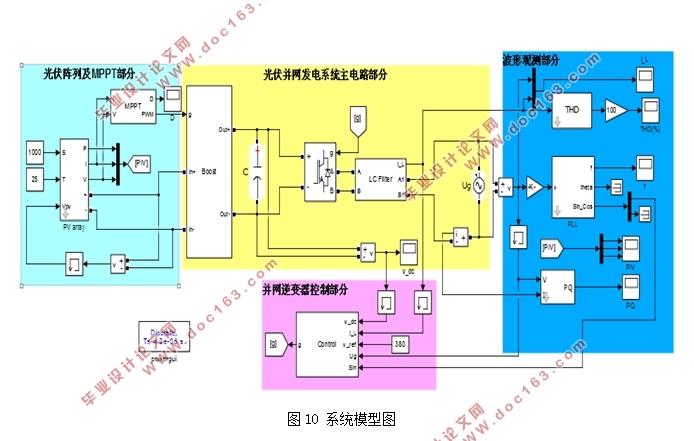基于MATLAB对太阳光伏单相逆变并网系统的仿真分析

1.无需注册登录,支付后按照提示操作即可获取该资料.
2.资料以网页介绍的为准,下载后不会有水印.资料仅供学习参考之用.
密 惠 保
基于MATLAB对太阳光伏单相逆变并网系统的仿真分析(论文13000字)
摘要:本文采用MATLAB对太阳能电池进行仿真分析,模型整体结构分为四大部分:主电路部分、控制系统部分、光伏阵列以及电导增量法MPPT部分模型。本文采用光伏并网逆变器,前级DC/DC 变换器和后级的 DC/AC 逆变器。并网运行时,DC-AC 逆变环节主要使输出电流与电网电压同相位,同时获得单位功率因数。仿真结果波形观测部分:并网电压电流波形、谐波畸变率THD波形、并网电流频率波形、电池阵列的功率,电流,电压波形、并网输出的有功率和无功功率波形。仿真结果表明整个系统实现了DC/AC变换,且并网电流正弦度高,满足并网标准和要求。
关键词:太阳能光伏发电;最大功率跟踪(MPPT);电导增量法;逆变并网
Solar photo-voltaic power generation system
Abstract:In this paper, the simulation analysis of solar cells is carried out. The whole structure of the model is divided into four parts: the main circuit part, the control system part, the PV array and the conductivity increment MPPT part model. In this paper, the use of photo-voltaic grid-connected converter, the former DC / DC converter and the subsequent DC / AC converter. When the grid is running, the DC-AC converter mainly makes the output current in phase with the grid voltage, and obtains the unit power factor. Simulation results Waveform observation section: Grid voltage and current waveform, harmonic distortion rate THD waveform, grid current frequency waveform, battery array power, current, voltage waveform, and the output of the power and reactive power waveform. The simulation results show that the whole system realizes the DC / AC conversion and the sinusoidal current is high, which meets the grid standard and requirements. [资料来源:http://www.THINK58.com]
Key words:solar energy; maximum power tracking (MPPT);Converter grid;Conductivity increment;
[版权所有:http://think58.com]

目 录
摘要 I
Abstract II
1.开发太阳能的意义和国内外现状及前景 1
1.1全球能源危机和太阳能的必要性 1
1.1.1能源紧缺危机及环境污染等问题 1
1.1.2太阳能资源的开发和运用 1
1.1.3优点及缺点 2
1.2国内外光伏发电现状及发展 2
1.2.1在国外的光伏发电现状和发展前景 2
1.2.2在国内的光伏发电现状和发展前景 4
1.3本文主要研究的内容 5
2.太阳光伏单相逆变并网系统的概述 6
2.1太阳能光伏发电的技术 6
2.2单相逆变并网发电系统说明 6
2.3太阳光伏逆变并网系统的应用 6 [资料来源:THINK58.com]
3.光伏电池的工作原理 7
3.1太阳能光伏系统的工作原理 7
3.1.1太阳能光伏发电系统组成部分 7
3.1.2太阳能电池的发电原理 7
3.2太阳能电池的分类 8
3.3太阳能电池的等效电路 9
3.4太阳能电池的转换效率 9
4.研究最大功率点跟踪 11
4.1太阳能电池最大功率点跟踪的原理 11
4.2太阳能电池的输出特性 11
4.3最大功率点追踪方法 12
4.3.1电导增量法 12
5.太阳光伏单相逆变并网系统的仿真分析 15
5.1仿真模型工作原理 15
5.2模型结构 15
5.3光伏阵列的建模具体过程 18
5.4逆变器并网控制原理 19
5.5主要并网波形分析 20
参考文献: 21
致谢 23
[资料来源:http://www.THINK58.com]
